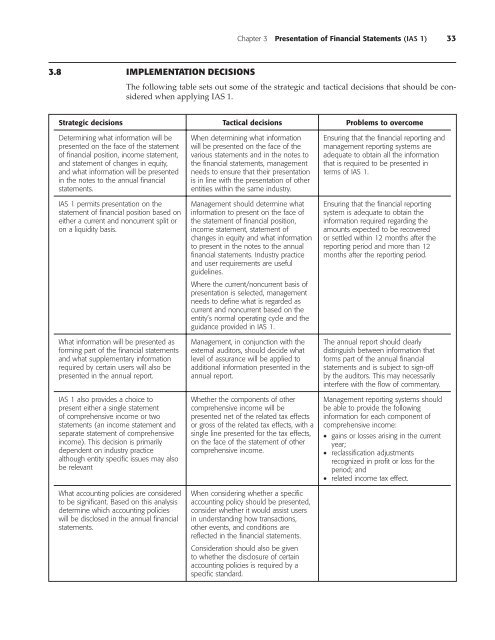International Financial Reporting Standards_guide.pdf
International Financial Reporting Standards_guide.pdf
International Financial Reporting Standards_guide.pdf
Create successful ePaper yourself
Turn your PDF publications into a flip-book with our unique Google optimized e-Paper software.
Chapter 3 Presentation of <strong>Financial</strong> Statements (IAS 1) 33<br />
3.8 IMPLEMENTATION DECISIONS<br />
The following table sets out some of the strategic and tactical decisions that should be considered<br />
when applying IAS 1.<br />
Strategic decisions Tactical decisions Problems to overcome<br />
Determining what information will be<br />
presented on the face of the statement<br />
of financial position, income statement,<br />
and statement of changes in equity,<br />
and what information will be presented<br />
in the notes to the annual financial<br />
statements.<br />
IAS 1 permits presentation on the<br />
statement of financial position based on<br />
either a current and noncurrent split or<br />
on a liquidity basis.<br />
What information will be presented as<br />
forming part of the financial statements<br />
and what supplementary information<br />
required by certain users will also be<br />
presented in the annual report.<br />
IAS 1 also provides a choice to<br />
present either a single statement<br />
of comprehensive income or two<br />
statements (an income statement and<br />
separate statement of comprehensive<br />
income). This decision is primarily<br />
dependent on industry practice<br />
although entity specific issues may also<br />
be relevant<br />
What accounting policies are considered<br />
to be significant. Based on this analysis<br />
determine which accounting policies<br />
will be disclosed in the annual financial<br />
statements.<br />
When determining what information<br />
will be presented on the face of the<br />
various statements and in the notes to<br />
the financial statements, management<br />
needs to ensure that their presentation<br />
is in line with the presentation of other<br />
entities within the same industry.<br />
Management should determine what<br />
information to present on the face of<br />
the statement of financial position,<br />
income statement, statement of<br />
changes in equity and what information<br />
to present in the notes to the annual<br />
financial statements. Industry practice<br />
and user requirements are useful<br />
<strong>guide</strong>lines.<br />
Where the current/noncurrent basis of<br />
presentation is selected, management<br />
needs to define what is regarded as<br />
current and noncurrent based on the<br />
entity’s normal operating cycle and the<br />
guidance provided in IAS 1.<br />
Management, in conjunction with the<br />
external auditors, should decide what<br />
level of assurance will be applied to<br />
additional information presented in the<br />
annual report.<br />
Whether the components of other<br />
comprehensive income will be<br />
presented net of the related tax effects<br />
or gross of the related tax effects, with a<br />
single line presented for the tax effects,<br />
on the face of the statement of other<br />
comprehensive income.<br />
When considering whether a specific<br />
accounting policy should be presented,<br />
consider whether it would assist users<br />
in understanding how transactions,<br />
other events, and conditions are<br />
reflected in the financial statements.<br />
Consideration should also be given<br />
to whether the disclosure of certain<br />
accounting policies is required by a<br />
specific standard.<br />
Ensuring that the financial reporting and<br />
management reporting systems are<br />
adequate to obtain all the information<br />
that is required to be presented in<br />
terms of IAS 1.<br />
Ensuring that the financial reporting<br />
system is adequate to obtain the<br />
information required regarding the<br />
amounts expected to be recovered<br />
or settled within 12 months after the<br />
reporting period and more than 12<br />
months after the reporting period.<br />
The annual report should clearly<br />
distinguish between information that<br />
forms part of the annual financial<br />
statements and is subject to sign-off<br />
by the auditors. This may necessarily<br />
interfere with the flow of commentary.<br />
Management reporting systems should<br />
be able to provide the following<br />
information for each component of<br />
comprehensive income:<br />
• gains or losses arising in the current<br />
year;<br />
• reclassification adjustments<br />
recognized in profit or loss for the<br />
period; and<br />
• related income tax effect.

















